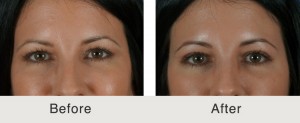CROWN:
6817 Fairview Rd Charlotte, NC 28210
The eyes convey our feelings, emotions, and well-being. The eyes are the focal point of the face and they are the location that people focus. A beautiful eye is bright, open and appears awake. It is easy to identify an eye that is youthful and awake and to identify one that appears heavy or fatigued.
When the appearances of the eyes do not reflect how we feel on the inside, patients often want to know their options to improve the appearance of their eyes. One of the best options to restore a proportional eye is blepharoplasty surgery. A blepharoplasty or eyelid lift is a surgical procedure to enhance the appearance of the eye and reverse the aging changes.
In this blog, I would like to talk about the characteristics of an attractive eye, the changes that occur around the eyes during aging, the details of a blepharoplasty, and the best age to undergo an eyelid lift.

As a facial plastic surgeon in North Carolina, the adjectives that I would ascribe to a beautiful eye are:
I like to look at the eye region and see how light interacts in the area. When light is reflected around the eye, it will create a bright and open appearance. Light reflects off of a smooth surface that comes out of the face. If the area around the eye has depressions, bags, circles, or irregular surfaces, it can cause shadowing around the eye. Shadowing can create a fatigued or tired look.
In the upper eyelid, one of the most important proportions is the relationship between the upper eyelid crease and eyelashes. A clean and smooth curving eyelid crease a few millimeters above the eyelashes creates a great shape and form to the upper eyelid. If this upper eyelid crease is low, uneven, or disappears, it can create an eye that appears heavy or tired.
The eyes are one of the first areas that begin to show changes from aging. During the aging process, a few changes may occur in the eyelid region:
All of these changes reduce the amount of light the eye region reflects and creates an eye that appears less awake and heavy.

A blepharoplasty can be completed on the upper eyelids, lower eyelids or both the upper and lower eyelids at the same time. When both the upper and lower eyelids are done at the same time, the surgery is referred to as quad blepharoplasty. Let’s first talk about an upper eyelid lift.
The entire goal of an upper eyelid lift is to create a beautiful eyelid crease that’s defined and has a gentle sloping arch. This is achieved by manipulating the skin and fat of the upper eyelid.
There are instances where only the extra skin has to be removed and there are times where the fat of the upper eyelid has to be moved into a better location to create a better curve.
Recovery for this procedure is quick and with little discomfort.
The goal of a lower eyelid lift is to create a smooth surface or transition from the lower eyelid to the cheek. Similarly to the upper blepharoplasty, both fat and skin is manipulated in this region to achieve this goal. If there is excess skin present, a small incision will be made underneath the eyelashes to remove the excess skin.
The bag and circles underneath the eyes are caused by excess fat. The bags are best treated by moving the fat down into the cheek region to create a smoother surface. If the skin is damaged and wrinkly from sun damage, a chemical peel could be used to tighten and rejuvenate the skin. The recovery for a lower blepharoplasty is generally 1 week.
I generally group patients considering undergoing a blepharoplasty into 2 groups:
There are a few general requirements that must be met before patients can undergo a blepharoplasty. I want to ensure that they are in great health and they are comfortable in their decision to undergo surgery. In my opinion, the timing to undergo these procedures is based on the patient’s anatomy, not their age. If a young patient comes to my office in their 20’s with heavy upper eyelids, I would recommend an upper blepharoplasty because their anatomy is not going to improve with time.
Some patients will develop bags under their eyes in their 30’s while other may not develop them until their 60’s. I believe the best time to undergo a lower blepharoplasty is when the appearance of the lower eye changes and the smooth transition from the eyelid to the cheek is not present.
Generally speaking, there are some advantages to undergoing the procedure earlier than later. Typically speaking, younger patients are generally healthier and they will recover faster. At an earlier age, the aging changes are less advanced. With less advanced changes, we can use less aggressive surgery.
Patients are typically concerned with the longevity of a blepharoplasty. After the completion of a blepharoplasty, the aging process does not stop. For that reason, the area around the eye will change overtime, but the eyes will always look better than if the patient did not have the procedure. For this reason, the improvement from the blepharoplasty is permanent and long lasting.

If you are interested in blepharoplasty surgery, please call our office at (704) 842-3644 or fill out the online contact form to schedule a consultation with Dr. Kulbersh.